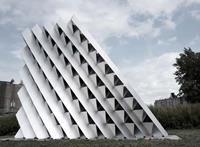Applicable Experiments: Collaborative Models for Material Research

This article presents strategies for forging collaborative architectural practices between universities and manufacturing industries. It focuses on current architectural research, its explicit impact on manufacturing processes, and the influence of these processes on design outputs. Specifically, the authors discuss examples of collaboration between faculty and students at the University at Buffalo Department of Architecture, and manufacturing industries initially based in the Buffalo, but more recently, a network of architects, manufacturers, and engineers across the globe.
This article has four thematic objectives: to describe the procedures by which two faculty developed, designed, and fabricated a prototype in collaboration with an industrial manufacturer, and utilized the described framework in developing a proposal for an intense collaboration; to identify how architects are utilizing digital tools to facilitate collaboration among diverse Architecture, Engineering, and Construction (AEC) teams with the goal of merging design and construction into an integrated workflow; to catalog how new means of interfacing with information and an increased proximity to the production of products/objects through CNC machinery is reshaping a renewed material-centric practice in architecture and its related fields; and, to assess the capacity of parametric design software and how this method of working/ thinking has allowed architects to streamline drawing-to-production methods.


Add comment
Log in to post comments